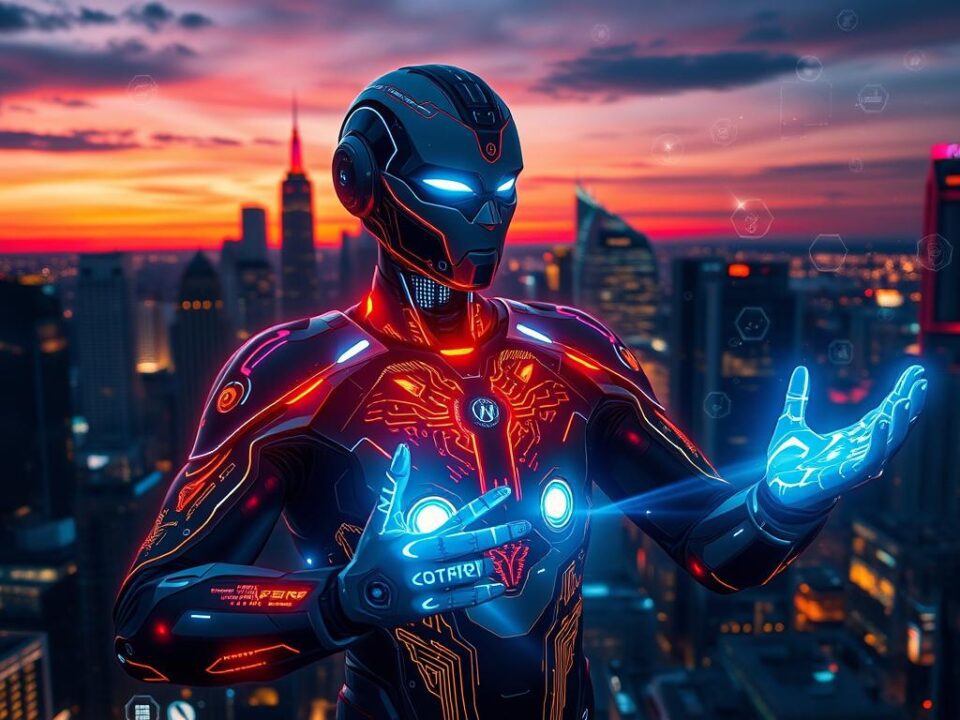The world of crime fighting is changing fast, thanks to technology. The idea of an AI crime fighter brings back memories of KITT from “Knight Rider” in 1982. Today, this AI helps law enforcement in new ways, using data and quick decisions to keep us safe.
Crime prevention is more important than ever, and AI is key to helping police. This article shows how AI helps in investigations and even predicts crimes. It’s a new way to keep our communities safe. Let’s see how AI is becoming a hero in fighting crime today.
Introduction to AI Crime Fighters
AI crime fighters are advanced systems that use artificial intelligence to help law enforcement. They can analyze huge amounts of data, spot patterns, and predict crimes. This marks a big step forward in keeping communities safe.
What is an AI Crime Fighter?
An AI crime fighter uses tech like machine learning to aid in solving crimes. Researchers in Spain are training AI with thousands of crime scene images. This helps find important clues like footprints and shoe models.
Police around the world can now identify suspects using facial recognition. This is a key part of using technology to prevent crimes.
The Importance of Technology in Crime Prevention
Technology has changed how police work, making it more efficient. AI can do tasks that used to take a lot of human effort. For example, facial recognition is used in over 60 countries.
Tools like PredPol have even cut crime by up to 10% in New York City. This shows how AI can make a big difference in keeping people safe.
The Role of AI in Modern Policing
Artificial intelligence is changing how police work. It helps them analyze data better. This leads to smarter decisions and safer communities.
Enhancing Crime Data Analysis
AI makes it easier for police to handle big data. It’s key for spotting trends and predicting crimes. For example, AI looks at past data to find where crimes might happen next.
It also helps find missing people and catch criminals. AI can scan videos for faces and cars in real time. This makes it easier for police to do their job.
Predictive Policing: How It Works
Predictive policing uses past crime data to plan police actions. AI looks at many factors to guess where crimes might happen. This helps police plan their routes and shifts better.
It also means police can respond faster in emergencies. This way, they can tackle problems quickly, keeping everyone safe.
Real-World Applications of AI in Law Enforcement
AI has changed how police fight crime and keep us safe. Many examples show how AI helps in law enforcement. These examples show how technology is making a big difference.
Case Studies of AI Success Stories
AI has made a big impact on crime prevention and solving cases. Here are some examples:
- In Chicago, AI helped cut robberies by 12%, burglaries by 21%, and car theft by 32%.
- The Los Angeles Police Department used Big Data analytics since 2010. It helped them be more proactive.
- In Ontario, Canada, AI predicts homelessness. This helps authorities plan better and prevent problems.
Tools and Technologies Used
Many advanced tools help police do their job better. This shows how important technology is for policing:
- Facial Recognition Technology: This tool matches faces in databases, making investigations easier.
- Machine Learning Algorithms: These analyze data to help predict crimes.
- Surveillance Camera Analytics: AI checks video feeds for danger, ensuring quick responses.
- Social Media Monitoring: AI watches online activity to spot threats early.
The Advantages of Utilizing AI for Crime Fighting
Artificial intelligence is changing how police work. It makes them more efficient and keeps people safer. AI helps solve crimes faster, which means police can act quicker to stop threats.
Efficiency and Speed in Investigations
AI can look through lots of data fast. For example, digital assistants can quickly find important info in reports. This makes it easier for police to solve cases faster.
AI also helps find key words in digital chats. This means police can spot dangers sooner. So, they can solve crimes quicker and keep everyone safer.
Increasing Public Safety
AI makes police work better, which makes everyone safer. It can even predict crimes before they happen. This is like what you see in shows like “Person of Interest.”
AI also checks police actions after incidents. This helps reduce mistakes during important times. So, AI helps build trust between police and the community.
Challenges and Limitations of AI Crime Fighters
AI in policing has both good and bad sides. A big worry is privacy, as these systems watch people closely. This has made people question if it’s right to spy on everyone.
Police must find a way to keep us safe without taking away our privacy. This is a tough task.
Data Privacy Concerns
More and more, people are worried about how AI watches us. These tools are used everywhere in law enforcement. But, they make people feel like they’re being watched all the time.
This can make people not trust the police. It’s a big problem.
Potential for Bias in Algorithms
AI can also be unfair because of biases in its programming. Studies show that many AI tools are made with biased data. This means some groups are unfairly targeted.
This unfairness can make things worse, not better. It’s a big challenge for AI in policing.
The Future of AI in Criminal Justice
The world of law enforcement is changing fast, thanks to new tech and AI. Looking ahead, we see new ways to fight crime and keep communities safe. These changes make law enforcement more efficient and open up new ways to prevent and solve crimes.
Emerging Trends in AI Technology
Crime is getting smarter, and so are the tools to stop it. We’re seeing new tech in crime fighting, including:
- Enhanced predictive analytics to predict crimes based on past data.
- Real-time facial recognition to quickly find suspects.
- AI for monitoring social media to spot threats or illegal acts.
- Advanced crime mapping to find high-risk areas.
This new tech is changing how police work. It lets them act fast against new crimes and safety issues.
Impact on Law Enforcement Jobs
AI in policing raises questions about jobs. While some tasks might be automated, more people will be needed to manage these systems. Police will need officers with:
- Technical skills to use and understand AI data.
- Analytical skills to use AI in new ways.
- Ethical awareness to handle data and algorithms in policing.
AI will make police work better but also change what officers need to know. They’ll need new skills and training to handle these changes.
Community Engagement and AI Tools
Using AI in policing needs strong community support. It’s key to build trust in AI. Police must talk openly with the public about AI’s role in fighting crime.
Building Trust in AI Solutions
Being open about AI in policing helps address public worries. Talking about AI’s algorithms and how they work is crucial. When people understand AI, they’re more likely to support it.
Teaching the public about AI in crime fighting helps. It makes people feel like they’re part of the effort. This partnership boosts AI’s role in solving crimes.
Education and Transparency with the Public
Workshops and online forums can teach people about AI in policing. It’s important for police to explain what AI can and can’t do. Sharing success stories with AI helps build trust and encourages people to join in.
Collaborative Efforts: AI and Human Officers
The mix of artificial intelligence and human officers is key in today’s policing. As police use more AI, training is vital. This ensures officers can use AI tools well, creating a strong partnership between humans and AI.
Training Police to Use AI Effectively
AI training programs are crucial for police. They teach officers how to use AI systems. These programs include:
- Hands-on workshops to get officers familiar with AI tools.
- Education on what AI can and can’t do.
- Training for making better decisions with AI help.
This training helps officers work well with AI. It lets them make smarter choices with AI’s help.
Bridging the Gap: Humans and Machines
It’s important to close the gap between human and AI thinking. Ways to do this include:
- Encouraging open talks between AI and officers.
- Using human judgment in big decisions, alongside AI.
- Getting feedback from officers to improve AI.
Training and understanding each other’s roles are key. This builds a strong partnership between humans and AI in law enforcement.
Ethical Considerations in AI Crime Fighting
Artificial intelligence is becoming key in law enforcement, but ethical issues in AI are critical. AI in policing needs clear guidelines and best practices to ensure fairness and accountability. It’s vital to establish ethical use frameworks as communities face these new technologies.
Establishing Guidelines and Best Practices
Best practices for policing with AI help avoid bias and discrimination. Agencies should focus on:
- Being transparent about AI use to build trust in communities.
- Regularly checking AI systems for bias and fixing it.
- Training officers on using AI ethically.
These steps help meet ethical standards and reduce public worries about AI.
Addressing Public Concerns
People worry about privacy and wrongful arrests with AI. It’s important to talk openly about these fears. Holding public forums can help explain how AI is used responsibly in crime fighting.
Highlighting accountability in AI systems can ease these concerns. This approach boosts trust in law enforcement’s AI efforts.
How Citizens Can Support AI Crime-Fighting Initiatives
Citizens play a big role in helping police use AI to fight crime. To do well, police need help from the community. This means reporting crimes and using new technology. Together, we can make our neighborhoods safer.
Reporting and Sharing Information
One great way to help is by reporting crimes. Using AI can make this reporting better. Here’s how:
- Report odd activities through apps that use AI to spot patterns.
- Join neighborhood watch groups to share info with police right away.
- Be part of social media groups that talk about stopping crime and keeping safe.
By reporting crimes, police can act fast and right. This helps keep everyone safe.
Engaging with Local Law Enforcement
To really help AI efforts, talk to local police. Going to community meetings lets you:
- Talk about AI plans and how to make them better.
- Find out how AI helps police do their job.
- Share thoughts on AI tools that affect our safety.
Talking to police builds trust. It also helps everyone work together. When we understand and use AI, we help police do their job better.
Conclusion: The Path Ahead for AI Crime Fighters
The future of AI in policing is both promising and challenging. It’s key to find a balance between new tech and fair policing. AI can make law enforcement better, but it must be used ethically and with human checks.
Creating rules for AI is vital. These rules should help both police and the community. This way, AI can help keep everyone safe.
Balancing Innovation with Responsibility
AI in policing needs to keep trust high. Trust helps the community work with police and new tech. Talking openly about AI’s role can ease worries and show its good sides.
The community’s opinions should guide AI use in policing. This way, AI helps everyone, not just the police.
The Importance of Community Trust
Building trust is crucial in the AI era of policing. Trust helps people accept new tech and ensures policing meets public needs. If trust grows, AI can make policing safer and more efficient.
This will lead to a future where policing is fair and effective. It’s a step towards a safer world for all.







